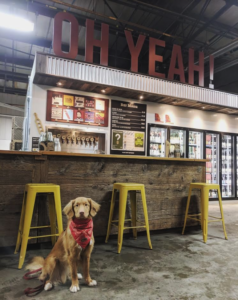February 21, 2019 Hi there!
This page is your closer look at the materials outlined in the pamphlet, The Brewing Process: A Self-guided Tour. We hope you enjoyed your visit to the brewery, and we hope you enjoy this supplemental virtual tour guide!
As mentioned in the pamphlet, our brewery was founded in 2006 by father and son Tim and Steve Beauchesne. We are an employee-owned, certified organic and proudly independent craft brewery. For more about the Beau’s story, visit out About Us page. For more info about Beau’s and beer, our blog is a great resource.
1. First up, get familiar with the ingredients WATER
Beer is more than 90% water, so the quality of your water greatly affects the quality of your beer. At Beau’s we only use local spring water.
HOPS
Hops provide bitterness to balance with the sweetness from malts, and a wonderful aroma that can range from pepper to citrus to earthy, depending on the variety. They are also a natural preservative that helps to keep beer fresh. Our hops are certified organic.
MALTS
Malts provide the colour and the sweetness in beer, as well as providing the sugar that the yeast need to feed upon during fermentation. All of the malted grains we use are certified organic.
YEAST
The ingredient that turns flour into bread is the same one that turns sweet barley juice into beer. We use different yeast strains for different beers, each perfectly developed over centuries to provide specific aromas and flavours to specific styles.
2. Next up, The Brewhouse The heart of the brewery. The brewhouse at Beau’s is composed of four main vessels: the Hot Liquor Tank (or HLT), the Mash/Lauter Tun, the Kettle and the Whirlpool.
A. HOT LIQUOR TANK
The HLT heats up our spring water to the exact temperature required to start brewing. Once the water is at the right temperature, we’re ready to mill our grains.
B. MASH/LAUTER TUN (AND MILL)
The mash/lauter tun is a combination vessel. Mashing is the combination of the grist (malt) and the hot liquor (brewing water) to create a mash, which is held at a set temperature and in a set pH range to optimize the conversion of starches into sugar by the enzymes present in the malt. Lautering is the separation of the liquid wort from the grist. In the mash tun, the grain is mixed with the hot liquor, where it is steeped. During this time the starches in the grains are converted into sugars due to the hot temperature of the water.
C. KETTLE
Once the starches have converted to sugars, we start to move the liquid (now called wort) into the kettle. We continue to add more water on top of the grains until we have exactly the right amount of sugar in the wort and then we bring the kettle to a full rolling boil. Once the boil starts, we begin adding hops to the liquid. The earlier the hops are put into the boil, the more bitterness they impart; the later they are added, the more aroma.
D. WHIRLPOOL
The whirlpool is a vessel to separate solid materials (trub) in the wort from the liquid wort. The solids – or trub – would be hops, and the proteins that precipitate out during the boil, known as the hot break. The separation happens by introducing the wort into the vessel at a tangential angle, creating the whirlpool motion of the wort inside the vessel. As the spinning liquid slows down, the heavier particles collect in the centre, creating a trub pile. The clear liquid wort can then be pulled off from the side of the vessel and the trub pile left behind.
3. The next steps: Fermentation and Aging FERMENTATION
After the wort has finished boiling, the liquid is transferred to a fermenter and cooled. Brewer’s yeast is added to the tank at the same time. The yeast is a living organism that lives by eating the sugar in the liquid and giving off alcohol and carbon dioxide. After about a week, there is very little sugar left in the liquid and the yeast become dormant and settle to the bottom of the cone in the fermenter, where they are then harvested to go into the next batch of beer.
AGING
Aging happens in the same tank. We age our beer for a lengthy period, allowing it to develop flavours and crispness naturally.
Fun fact: Our fermentation tanks can accommodate up to 745,000 litres of beer at any given time!
4. Filtering After the beer has aged, if it is appropriate, we filter the beer. Many of our offerings are actually more flavourful unfiltered, so we skip this step sometimes, but Lug•Tread and a few of our other beers are filtered. To filter, we fill the filter with a mixture of water and diatomaceous earth (DE – soft rock made up of fossilized diatoms). The DE forms a cake on top of a series of about 25 screens. The beer is then passed through the screens. The composition of DE traps proteins and yeast, while allowing the rest of the beer to pass through. The filtered beer moves into a storage tank called a brite tank (once beer has been filtered it is called brite beer).
5. Packaging The beer in the bright tank is put into either a keg or a bottle, depending on its final destination. Either way we are careful to make sure the beer is not exposed to oxygen or light (the two big beer spoilers) in the process.
Fun fact: Our bottling line can fill up to 70 bottles per minute!
6. Enjoying! The best part of our day, and what transforms the brewing process into a labour of love.
Fun fact: 80% of the beer we produce is Lug•Tread lagered ale, our flagship beer!
Share:Original Source Here

